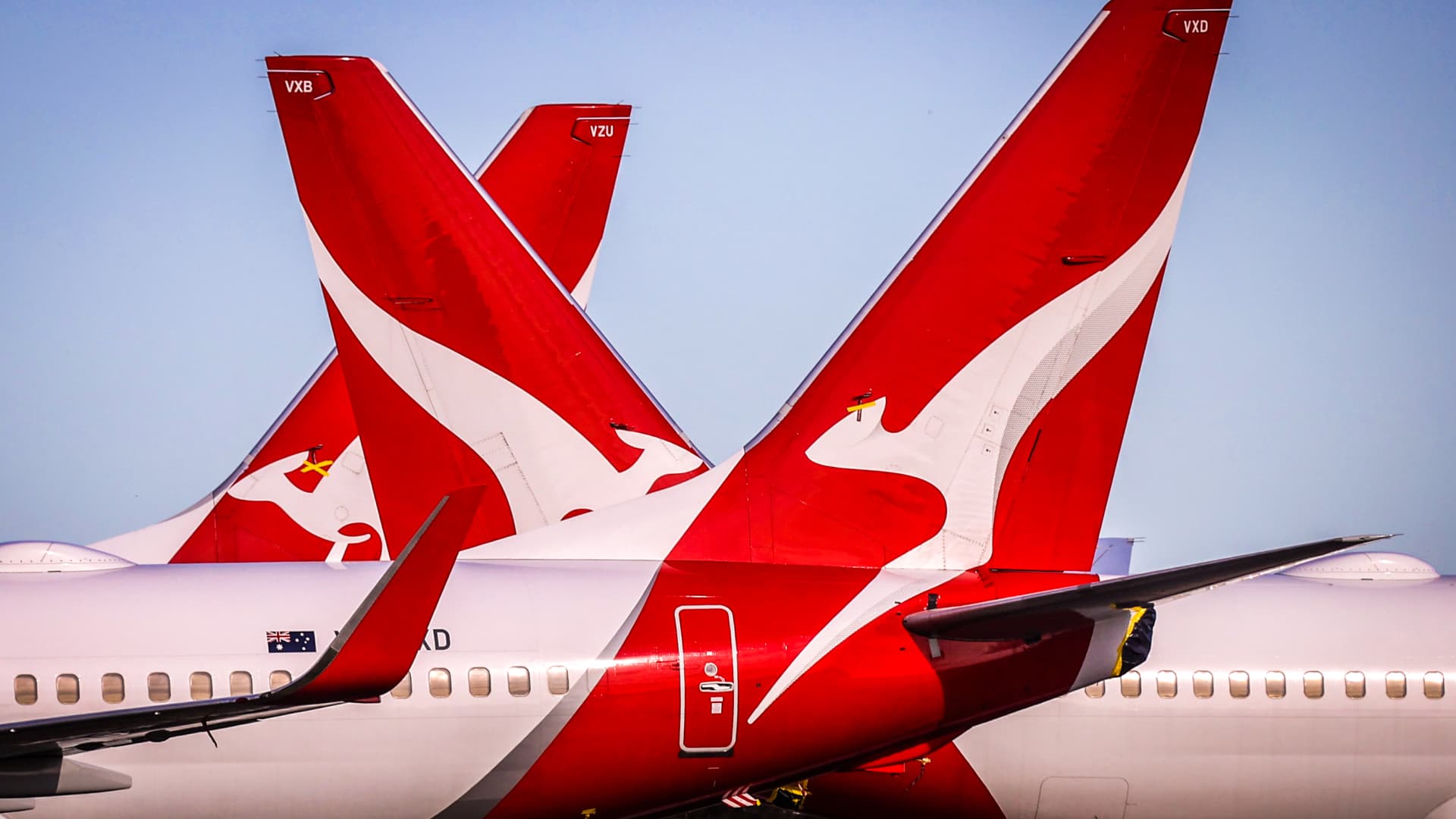Qantas Airways Boeing 737-800 planes sit parked on the runway at Sydney International Airport on July 22, 2020.David Gray | Getty Images News | Getty ImagesQantas Airways said on Monday it had ordered 12 A350-1000 planes from Airbus to be used on what will be the world’s longest commercial flight from Sydney to London, as well as 40 narrowbody jets to renew its domestic fleet.The deal comes as market conditions improve and demand for domestic and international travel recover from the pandemic faster than expected, allowing the carrier to reduce debt and forecast a return to profit in the financial year starting July 1.”The board’s decision to approve what is the largest aircraft order in Australian aviation is a clear vote of confidence in the future of the Qantas Group,” Chief Executive Alan Joyce said in a statement.Qantas did not disclose the value of the deal but it is likely to be in the billions of dollars based on aircraft list prices.Non-stop flights from Sydney to London, which will take nearly 20 hours, will begin in late 2025 following the delivery of A350-1000s, the airline said.The A350s will carry 238 passengers across first class, business class, premium economy and economy class, with more than 40% of the cabin dedicated to premium seating, it added.The deliveries of 20 A321XLRs will start in late 2024, while 20 smaller A220s will arrive from late 2023 – renewing the carrier’s ageing domestic fleet. The order also includes options to buy another 94 aircraft that would arrive through to 2034.”The phasing of this order means it can be funded within our debt range and through earnings, while still leaving room for shareholder returns in line with our financial framework,” Joyce said.The new domestic fleet “will reduce emissions by at least 15% if running on fossil fuels, and significantly better when run on sustainable aviation fuel,” Joyce said, further asserting that its “Project Sunrise” would be carbon neutral from day one.Qantas in December selected Airbus as the preferred supplier for a major order to renew its ageing narrowbody fleet, in a blow to incumbent supplier Boeing.Reuters on Sunday reported, citing sources, that the carrier was set to announce the deal that brings it closer to launching record-breaking direct flights of nearly 20 hours on the “Kangaroo route” between Sydney and London.In a separate filing, Qantas said while it expects an underlying operating loss for fiscal 2022, the second-half of the year would benefit from improved domestic and international demand with free cash flow seen rising further in the current quarter. .
How to choose the best seat on a plane
What used to be a simple part of purchasing an airline ticket has become a hot mess in recent years. Should you pay for more legroom? Should you pay at all? Do you have to select a seat in order to get on the plane? These are legitimate questions, and airlines do little to help answer them during checkout.
Here we offer simple, straightforward guidance for how to choose airlines seats, or how to skip seat selection altogether. Airlines have different rules and costs associated with seat selection yet all share many similarities. Mastering this basic yet important aspect of flying can make your trip more comfortable and save you a surprising amount of money. The big exception here is Southwest Airlines,
LUV,
+0.65%
which doesn’t follow the industry’s seat selection conventions.4 steps to selecting seats on planesStep 1: Pick an airline with lower seat selection fees Let’s take a step back: Yes, many airlines now charge a fee to select seats ahead of time. This is a relatively new reality in the travel world and isn’t consistent from airline to airline or even trip to trip. Therefore, it’s good to know which airlines are saddling customers with sky-high fees and which are keeping them modest, or skipping them altogether.
We determined these seat selection fees by looking across several fares and averaging the cost of choosing a window seat near the front of the plane and choosing a middle seat near the back.
-
Airlines like American Airlines,
AAL,
+2.92%
Spirit Airlines
SAVE,
+3.41%
and Frontier Airlines
ULCC,
+2.34%
charged high fees for both window seats near the front of the plane and middle seats near the back. -
Delta Air Lines
DAL,
+2.47%
and United Airlines
UAL,
+3.30%
only charged for the nicer seats. -
Alaska Airlines
ALK,
+1.47%
and Hawaiian Airlines charged nothing at all.
So you can save yourself some hassle by choosing an airline with more reasonable rules and fees. You don’t want to end up on the fifth checkout screen and realize that you owe $40 extra for your seat. Also see: American Airlines to resume in-flight alcohol sales in AprilStep 2: Skip seat selection if you have to pay Here’s the tricky underside of seat selection fees: You usually don’t have to pay them, but airlines really want you to. This gets especially confusing with basic economy fares, which differ from airline to airline and often don’t include free seat selection. But no matter what, you should skip seat selection altogether if the airline is trying to make you pay. Here’s an example. When trying to book a United basic economy fare, you might see that every available seat carries a charge, even the really lousy ones in the back.
You might think you have to shell out $14 extra on this flight, but not so: You can skip the seat selection process altogether and save that money. Does skipping seat selection mean you might not get a seat at all? Emphatically, no. You will likely get assigned a seat during check-in (though you should still skip it if the airline tries to tack on a fee) or, at the very least, at the gate. Again: You don’t have to select a seat in order to get a seat. You just might get stuck with a suboptimal one if you choose to skip it. It is important to note that if you’re traveling with others, there is no guarantee that your seats will be assigned together if you choose to forgo paying for seat selection, so you’ll need to factor that inconvenience into your decision.Step 3: Weigh the pros and cons of paying to upgrade your seat Most airlines now offer three categories of economy fares:
- Basic economy. These fares are highly restrictive and usually don’t include free seat selection.
- Economy (sometimes called “main cabin”). These are the normal economy fares.
- Premium economy (every airline has its own name). Premium economy fares often include perks like extra legroom and a free drink.
Some airlines even offer a fourth category:
- Economy preferred (or similar). These are usually economy seats with preferential placement, such as near the front of the plane and on the aisles and windows.
When you purchase one of these fares, your airline will probably ask whether you want to upgrade. Sometimes this will be an interstitial screen during checkout, such as this section from Delta:
More often, this choice will be baked into the seat selection screen. For example, if you select a Comfort+ (premium economy) seat on Delta, you’ll see the cost of upgrading to this seat along with some of the perks.
Feeling some decision fatigue yet? Don’t worry, here are some simple rules to follow:
- If you are not 100% confident in your plans, upgrade from basic economy to main cabin for better change/cancellation policies.
- If you must have a window or aisle seat, upgrade from basic economy to economy or economy preferred.
- If you must have more legroom, upgrade from main cabin (or main cabin preferred) to premium economy.
- When in doubt, don’t upgrade. These fees might seem small, but they can add up in a hurry, especially on round-trip flights.
Keep in mind that airlines have different names for these different upgrade options. Read: ‘At $4.39 a gallon for gas, it was going to cost me more to drive there and back — than it is to stay at the hotel’: Americans rethink spring travel plansStep 4: Check to make sure your seat selection is OK Assuming you have selected a seat and not chosen to skip it in step 2, you’ll want to make sure it’s a decent, comfortable option. This is especially important for long international flights where the difference between a cramped seat by the bathroom and a bulkhead seat with extra legroom can be a big one. Some airlines include information about the seats during the seat selection process, but remember that they are trying to upsell you on an upgrade, so take this with a grain of salt. Instead, consult a third-party website like SeatGuru. SeatGuru includes detailed information about each seat in most major airlines’ fleets. It has a color-coded map that lets you easily spot the best and worst seats onboard. The easiest way to find your aircraft is to use the search tool on SeatGuru’s homepage. Fair warning: SeatGuru is not the most user-friendly site. It’s still so much better than all the competition that it remains the go-to resource for fleet-specific seat info. You might like: How to get a travel rewards card if you’re just building creditKey takeaways Don’t be overwhelmed by the process of learning how to pick flight seats. Airlines have made it that way on purpose in order to sell their more “premium” seating options. Understanding these basics can save you lots of money. When in doubt, keep it simple. Skip seat selection altogether if the airline is asking you to pay, knowing that you’ll still get assigned a seat before takeoff. And don’t upgrade your seat unless you absolutely must. Seating is just one of the ways that airlines have turned purchasing air travel into a gamut of add-on fees. Keeping your total cost down requires a bit of know-how and navigation, but is well worth the effort. More From NerdWallet Sam Kemmis writes for NerdWallet. Email: [email protected]. Twitter: @samsambutdif.
.



